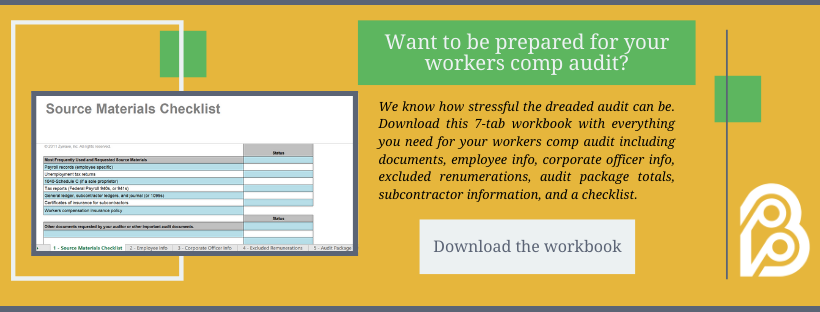8 Common Mistakes To Avoid on Your Insurance Audit
Business Insurance | General Liability | Workers Compensation
Originally published: May 16, 2024 | Updated: June 27, 2025
Unless you’re a new business owner, you likely have come to dread submitting your annual audit for workers’ compensation or general liability policies.
And believe us, you’re not alone! Navigating audits can be stressful and frustrating for any business owner - seasoned pro or otherwise. With their complexity, many business owners can find issues arising from even the smallest of mistakes made on their audit.
But don’t lose hope! Here at Berry Insurance, we frequently help guide business owners to make the process of submitting your audit as seamless as possible. So, in this article we’ll cover some of the most common mistakes made on audits and how you can avoid them!
Table of contents:
- Mistake #1: Not requesting a copy of the auditor’s worksheet
- Mistake #2: Incorrectly estimating payrolls
- Mistake #3: Being charged for insured subcontractors
- Mistake #4: Including or excluding officers
- Mistake #5: Not submitting all required documentation
- Mistake #6: Missing the deadline
- Mistake #7: Excluded remuneration
- Mistake #8: Misclassification
Mistake #1: Not requesting a copy of the auditor’s worksheet
Business owners should always be sure to request a copy of the auditor’s worksheets. These will show a complete breakdown of payroll so you can determine if any mistakes were made.
To request a copy of the auditor worksheets, you will have to send the insurance carrier a letter of authorization that is signed and currently dated by a listed owner of the policy. The letter must also be on the company letter-head.
Some carriers will accept just an email request, which is a good option to avoid delays. If you do send an email to your carrier, be sure to cc your insurance agent on your request.
If you do not request these, and there is an error on your audit, it can delay the audit dispute process - which in turn could delay any potential refunds/credits owed.
Mistake #2: Incorrectly estimating payrolls
Providing incorrect estimates on your company's payroll can cause further complications. When completing an annual review with your agent, be sure to give an accurate estimate of your payroll so you will be less likely to incur an additional premium from your audit.
Keep in mind that audit premiums are due in full. So if you provide correct estimates at the start of your policy, and you set your billing up in installments, the payments are easier to make.
If you underestimate your payrolls at the start of the policy, your audit could generate an additional premium that is due in full, and cannot be paid in installments.
Mistake #3: Being charged for insured subcontractors
Hired subcontractors must provide valid certificates to prove active coverage throughout the duration of the project. Certificates must also be continuous through your policy periods.
For example, let's say a business’ policy is from 2/15/2023 - 2/15/2024, and then they hire a subcontractor who provides a certificate showing 8/3/2022 - 8/3/2023.
From the business owners perspective, their subcontractor is insured from 2/15/2023 - 8/3/2023.
The subcontractor would need to provide a renewal certificate of 8/3/2023 - 8/3/2024 to be fully insured during the business’ policy period of 2/15/2023 - 2/15/2024.
If the subcontractor worked the time of 8/3/2023 - 2/15/2024, and didn’t provide their renewal certificate, the wages would be charged to the business on their audit - raising the policy premium.
Also be sure to check that owners are not excluded on the certificates of the subcontractors.
If one of your subcontractors is the owner of their business, and they do not carry insurance on themselves, their costs will be included in your audit and policy coverage.
Mistake #4: Including or excluding officers
If an officer is excluded, they should not have their payroll charged on the audit. If they are, you will find yourself overpaying on your policy premium.
Mistake #5: Not submitting all required documentation
When submitting your audit, be sure to include all required documentation. This can include:
- Gross payroll for each employee, including exact job duties. Show separately any overtime, tips, and severance pay by employee
- Average # of full-time and part-time employees
- Names, titles, duties, and % of ownership for all officers, members, partners, or owners, and their individual payroll amounts.
- 941 forms of the last four quarters
- Income statement/profit and loss statement
- Recent federal tax return (if required)
- Certificates for insured subcontractors
- Costs of materials furnished to subcontractors to install
- Gross sales by month, by location (General Liability audit specific)
- State sales tax reports to allow exclusion of sales tax (General Liability audit specific)
Please note that all records must match the audit dates, not your fiscal dates.
Mistake #6: Missing the deadline
As an audit is a requirement of all workers compensation policies, as well as most general liability policies, missing the submission deadline could cause severe problems.
If you don’t turn in your audit on time, you could potentially be canceled for non-compliance/material misrepresentation, or be issued an estimated audit where the carrier increases payroll, sometimes up to 50%.
Obviously no business needs that headache, which is why we urge you to mark your calendars and make sure you submit your audit prior to the deadline.
Mistake #7: Excluded remuneration
Make sure that your payroll records do not include any “excluded remuneration”, which can include:
- Tips and other gratitudes received by employees
- Severance payments (except for time worked or accrued vacation)
- Officer exemptions
- Payments for active military duty
- The value of special rewards for individual invention or discovery
- Employee discounts on goods purchased from the employee’s employer
- Expense reimbursements to employees if the employer's records prove that the expense was a legitimate business cost.
- Supper money for late work
- Work uniform allowances
- Sick pay given to an employee by a third party, such as an insurance company providing disability benefits to a disabled employee
- Payments made by an employer to furloughed employees due to the COVID-19 pandemic (This rule (V-B-3-m) is effective from March 1, 2020, until December 31, 2023, but this date might change based on state regulations. The rule will be automatically removed from this manual after it expires)
- The portion of Davis-Bacon wages, or similar prevailing wage law, that the employer proves was paid into a third-party employee benefit plan before the audit. This plan is managed without any direction or control from the employer or its officers, directors, or owners
Mistake #8: Misclassification
This can occur if one of your employees' job duties are not clearly defined, and their payroll is then lumped into the higher rate class for the audit. Make sure to double check the classification of your employees and payroll before submitting your audit.
If employees payroll is misclassified on your audit, their payroll would be charged at a higher rate, thus increasing your premium.
Less common mistakes to look out for:
- Having the wrong experience mod applied
- Deductions/credits not being applied
- Separation of payroll is not allowed - if an employee is handling more than one task, then you must provide the payroll breakdown by duties, so the auditor can allocate the payroll accordingly. Otherwise the auditor will be forced to hold the employee to the higher rated code of exposure at audit.
- Not adjusting your current policy to match the audited amounts. Some carriers will do this automatically, while others will not. If you are growing, and you don’t adjust your current term after the audit, you could be faced with an even higher audit the next time.
Making your audit seamless
We know how complex annual audits can feel for any business owner. But, now that you know what common mistakes to avoid on your next audit, you can hopefully get through the entire process without a hitch!
If you have additional questions or concerns regarding audits for your business specifically, be sure to reach out to your insurance agent.
For more information on navigating your workers’ compensation audit, read our guide on the 5 steps to get through your workers comp audit. And to learn what you should be preparing for your audit, download our workbook resources below!



